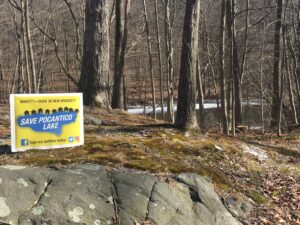
Developers of Meadows at Briarcliff, a proposed 31-home subdivision along Pocantico Lake Park that has met significant pushback from the community, are finalizing the Draft Environmental Impact Statement (DEIS) requested by the Mount Pleasant planning board. Brian Zappi of Zappico Real Estate Development LLC, said he hopes to submit it by the end of April.
Zappi said his group, which purchased the property in 2020 for $2.4 million, was interested in the parcel for its unique development potential that they believe could be constructed without environmental impact. “We studied all aspects of the proposed development for over a year prior to submitting an application to the town,” he told River Journal via email.
In June 2021, Zappi and brother Brandon Zappi presented their proposal to the planning board preloaded with their own traffic and bird studies. The parcel, located at 715 Sleepy Hollow Road, currently has two structures (a six-bedroom home plus caretaker house) on its vast acreage, and the plan would add 29 more four-bedroom homes on a 15-acre clustered subdivision.
Community members were prepared for the meeting and came armed with questions. While the park already has some homes built alongside it, they raised concerns about such significant development to the forested estate. The new homes will be perched on a steep slope above the lake, which was once a reservoir, and is a backup water source as well as a tributary to the Hudson River.

The lake and wetlands surrounding the Sleepy Hollow Road property encompass a 164-acre county park that comes with some interesting history. In the late 1980s, a proposed 43-home development along the Briarcliff Manor side faced similar community protest and was ultimately squashed. The county purchased the land, which was designated a Critical Environmental Area in 1990 for its “exceptional or unique character,” a stamp that provides it with strict protections.
Now residents have deftly organized once again to flood planning board meetings. They’ve cited the removal of one million square feet of trees as a significant concern and garnered nearly 900 signatures in a petition demanding the full environmental impact study.
Local resident Midge Bosak said the lake has seen an uptick in hikers, birdwatchers, and dog walkers enjoying the trails during the pandemic. She fears that pesticide and fertilizer runoff into the lake from the proposed development will destroy it. “I think anytime they pave over so much of the land, there’s no way they can keep chemicals and flooding from running into the lake. It’s just impossible,” she said.
Steven Bosak, Midge Bosak’s son, who was part of the original fight to preserve the land as president of the Pocantico Lake Civic Association, is disappointed to see the same battle being waged 30 years later. “I wish there was a higher value placed on protecting the natural beauty in that area because that’s one of the things that attracts people to Briarcliff and Westchester,” he said. “And appreciating that natural history, I think is important.”
Zappi said the opposition did not come as a surprise to him. “The people who are opposing the project fall into two categories,” he said. “The NIMBYs (not in my backyard) who are the most vocal and currently live on the lake with backyards down to the lake’s edge. The others seem to be misinformed and do not understand that this development will benefit the community by permanently preserving and protecting roughly 20 acres which is 60% of the property.”
Outside groups have also weighed in. After visiting the area and reviewing the plans, nonprofit environmental organization Scenic Hudson Valley determined that the proposed 31-home clustered subdivision could potentially endanger the watershed, and more needed to be known about the impact the loss of trees would have on wildlife and the area’s habitat connectivity through the River Towns.
“It’s important that these open spaces don’t get chopped up so that at some point in the future we are looking at a series of disconnected ecological patches,” Jeffrey Anvezino, Scenic Hudson’s director of land use advocacy, said, noting that having trails and parks laced together benefits the community’s ability to “recharge their batteries” in nature as well.
Zappi believes that their review of the land accounted for concerns about the park’s visual and ecological impact. “Most of the community is concerned with the lake, however the proposed development is over 400 feet away and heavily screened from the surrounding community by the 20 acres of conservation land,” he said.
The DEIS scoping document includes a more thorough survey on trees, water resources, and the area’s flora and fauna. Once submitted, the town planning board will begin reviewing it as well as the proposed alternative plans included in the document.
All photos by Gina Carey.






